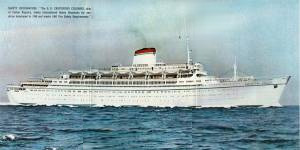SS Cristoforo Colombo

The SS Cristoforo Colombo
|
|
| History | |
|---|---|
| Name: | SS Cristoforo Colombo |
| Namesake: | Christopher Columbus |
| Owner: | Italian Line |
| Port of registry: |
|
| Builder: | Ansaldo Shipyards of Genoa, Italy |
| Launched: | 1953 |
| Maiden voyage: | 1954 |
| Fate: | Scrapped 1982 at Kaohsiung, Taiwan |
| General characteristics | |
| Class and type: | Ocean liner |
| Tonnage: | 29,191 gross tons |
| Length: | 700 feet (216.6 m) |
| Beam: | 90 feet (27.9 m) |
| Installed power: | Steam turbines |
| Propulsion: | Twin screws |
| Speed: | 23 knots |
| Capacity: |
|
SS Cristoforo Colombo (Italian pronunciation: [kriˈstɔːforo koˈlombo]) was an Italian ocean liner built in the 1950s, sister ship of the SS Andrea Doria.
The origins of the Cristoforo Colombo lie in the situation of the Italian Line at the end of World War II. The war had been devastating to them, as two of their newest and largest ships - the SS Rex and SS Conte di Savoia - had been destroyed. The Italian Line at this point decided to build only moderately-sized ships that were very luxurious, comfortable, and stylish.
The Cristoforo Colombo was built in Genoa at the Ansaldo Shipyards. The Andrea Doria was already built by the time Cristoforo Colombo was completed. She was launched in 1953 and was ready for a 1954 maiden voyage. When launched, the Cristoforo Colombo was larger than the Andrea Doria. Hence, the ship was the largest merchant ship in Italian service.
After the Andrea Doria was sunk after a collision with the in 1956, the Cristoforo Colombo was on her own until 1960 when the ship was joined by the Andrea Doria's replacement, SS Leonardo da Vinci.
In the spring of 1964, the Cristoforo Colombo carried the Pietà from the Vatican to the 1964 New York World's Fair. Pietà was put in a crate that was filled with plastic foam, which was lowered onto a rubber base in the first class pool where the least damage was likely to happen to it. During the actual loading, the Cristoforo Colombo had been put in dry dock so that she would not move and jeopardize the crate and its content. Only easily removable snap hooks secured the crate so that it could be released easily in case of accident. In case the Cristoforo Colombo sank during the voyage, the crate had the ability to float. In New York, the crate was lifted by a heavy-lift floating crane onto a barge that was put alongside the ship.
...
Wikipedia
